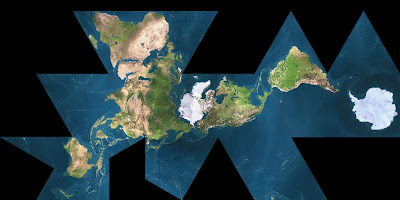In the exhibition After Nature at the New Museum in NY, the artworks represent a landscape of the future inspired by dystopian literature and sci fi culture. It gives a bleak vision of the future, depicting the fears and desires of the the 26 artists whose work contributed to the show. When viewing much of the work I was reminded of Alan Weisman's book The World Without Us, which is a scientific examination on how the world would look if humans were to disappear instantaneously. I first learned about this book from Weisman's appearance on the Daily Show back in 2007, and it seems the commercial success of this book triggered a post-nature, futuristic trend in art, literature and culture. For example, I now see all sorts of hour-long programs on the History Channel, which I just found out is a series called "Life After People," addressing the idea of what would happen to the world if people were to suddenly disappear.
The 2012 doomsday event, which was predicted by the ancient Mayans, is fast approaching and probably fresh on every one's mind, not to mention also being capitalized on by Hollywood in the upcoming film 2012. Whether it be the Mayans' 2012 theory, Nostradamus, or the Book of Revelation, humans have been fascinated with our own demise for millenna, and still are today. But even though I actually really enjoy the prospect of an imminent doom for all humanity, it seems like bad karma that people are putting so much thought to our own demise, as though we are not only anticipating human extinction to come soon, but that the more we talk about it, write books about it, make movies about it, the more of a likelihood it will become. It is as though we feel we deserve it, for whatever reason, and will thus welcome it with open arms.
When looking at the artworks in After Nature I noticed one of the audio clips mentioned Robert Kusmirowski's full scale replication of the Unabomber's cabin, but I didn't see a visual of it on the website. So I looked it up, and sure enough, there was a full scale model of the Unabomber's cabin in the show. It seemed severely out of place with the rest of the art, although I can't say this with total certainty because I wasn't actually there to see it, but in the audio clip the show's director describes it as representing trauma; that Ted Kaczynski represents a "crucial traumatic persona in the recent history of America."
Still, this doesn't seem to comply with the initial statement of the show as depicting "a universe in which humankind is being eclipsed and new ecological systems struggle to find a precarious balance." I wonder if it was meant to fit with the other works not in a literal way, but to add to the feeling of dread or hopelessness. No one likes a misunderstood-genius-serial killer and perhaps that was the sole basis for having this piece in the show. I listened to the audio selection of the Unabomber Manifesto, and I don't know how this was incorporated into the show or if this was strictly meant for the website.
I imagine the show was relatively ominous and bizarre compared to most other art shows, and this leads me to question if we are actually interested in the concept of "post-nature" or scared of it. Do people find the idea of a future dystopian world interesting or terrifying? I suppose both, and that is why it has been given so much hype lately, because it is both a fear and a fascination.
What is post-nature, anyway? Is it the idea of nature devouring humans or humans devouring nature? Who gets booted off the planet? This entire concept of a "post-nature" perpetuates the commonly held notion that people are separate from nature, insinuating that a war between humans and nature will determine the fate of our future. But no matter which side wins the battle, according to the After Nature show, the outcome will be bleak and dreadful. I think this whole concept is bogus. I think the term post-nature or post-black or any of the current "posts" that are being coined and circulated are nothing more than trendy and meaningless labels. Don't get me wrong, I like the idea of examining the future relationship between humans and nature, but to label it post-nature or after-nature seems dangerously anthropocentric to me.
Of Monkeys and Man
16 years ago
















